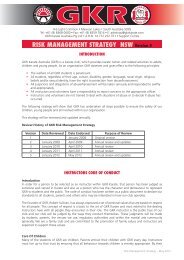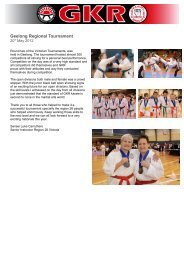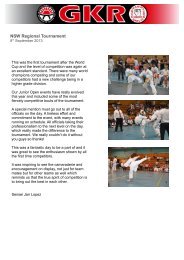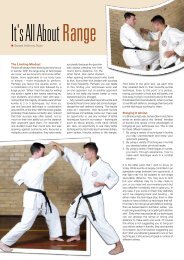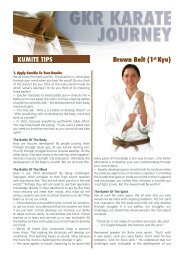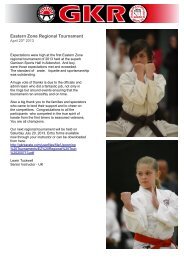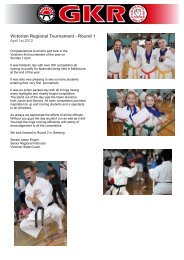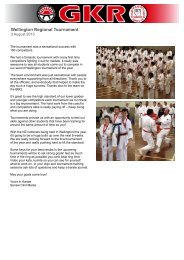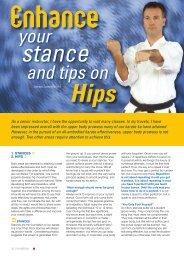Black Belt (2nd Dan) Kumite tips - GKR Karate
Black Belt (2nd Dan) Kumite tips - GKR Karate
Black Belt (2nd Dan) Kumite tips - GKR Karate
You also want an ePaper? Increase the reach of your titles
YUMPU automatically turns print PDFs into web optimized ePapers that Google loves.
<strong>Kumite</strong> Tips<strong>Black</strong> <strong>Belt</strong> (2 nd <strong>Dan</strong>)1. Develop Your Kaisho <strong>Kumite</strong>As a Nidan, you are introduced to kata Shisochin, whichis regarded as a kaishugata or kaishu kata, meaning openhanded kata. The term kaishu (or more commonly kaisho)means open hand. To coincide with your kaishugata(Shisochin), Nidan grades are permitted to begin theirkaisho kumite (open handed kumite). While many studentsare blocking with open hands well before Nidan, they areclosing their fists to strike. Kaisho kumite allows a studentto maintain open hands at all times.Warning: Be mindful that as a general rule open handstrikes are not permitted in kumite. This is because thepadding on our hand mitts does not fully cover the bladesof our hands, increasing the risk of injury. With this in mind,the development of kaisho kumite must be introducedslowly and very safely, preferably in randori kumite (mediumpaced, non-competitive kumite) with other high grades. Ifa Nidan is unable to perform kaisho kumite safely, they willbe told not to use it until a later date (when the instructorfeels they have developed more control and competency).Kaisho kumite striking techniques (such as haitos andshutos) should not be performed as they are in basics.Rather their preparation can be shortened allowing themto reach the target more quickly and adjust to varioustarget areas. Equally, they should be constantly flowingrather than performed as powerful techniques.The Advantages Of Kaisho <strong>Kumite</strong> Are:Open hands allow a karate-ka to block and quickly seize thestriking arm or leg. They may then use hikite (the pulling ofa seized arm or leg to control or destabilise an opponent)to put themselves in a highly dominant position.» Open hands allow for a variety of open-hand-strikes thatapproach an opponent from their periphery (their outside).Considering that human’s develop tunnel vision when ina PSCR state (a Psycho Chemical Stress Response stateassociated with combat), peripheral strikes can often takean opponent by complete surprise. Additionally, open handstrikes to atemi points (anatomical weak points) in real lifeself-defence can incapacitate a much larger attacker.Examples Of Kaisho Strikes In <strong>Kumite</strong> Are:• Inside shuto counter-attack with the front hand to theface.• Inside shuto attack or counter-strike off either hand tothe side of the head.• Inside shuto attack to the side of the ribs.• Outside shuto counter-strike off either hand to the sideof the head.• Pushing an opponent’s guard down with the front handand executing an outside shuto attack with the rearhand to the side of the head.• Otoshi shuto (downward knife strike - the ‘chop’) tothe trapezius muscle (located between the neck andshoulder).• Haito counter-strike off either hand to the side of thehead.• Haito attack to the side of the ribs (or wrapping aroundto the kidneys when in close).• Otoshi haito (downward knife strike, or ‘karate chop’)to the trapezius muscle (located between the neckand shoulder). This is especially effective after a lungepunch. This combination can be executed like a lunge,reverse punch combination, with the only change beingthe otoshi shuto replacing the gyaku tsuki.• Combinations of kaisho attacks where the hands start toflow, often striking with one arm twice before attackingwith the opposite arm.
• Combinations of attacks where you vary betweenperipheral open hand strikes and straight punches. Thiswill result in your opponent’s guard moving either inor out, allowing you to strike around or inside it. Thisis especially beneficial when conducting close quarterkumite and when developing your mushin (movingbetween attack and defence without thought).Examples Of Kaisho Strikes In Real-Life Self-DefenceAre:• Inside shuto to the neck, temple, Adam’s apple, nose orgroin (especially when an attacker is behind you).• Outside shuto to the neck, collarbone, temple or nose.• Haito (ridge hand) to the temple, neck, kidneys, groin(front on) or collarbone.• Teisho (palm strike) to the nose, chin or solar plexus.• Nukite (finger strikes) to the eyes or throat.• Kaisho Ura Uchi (open hand back fist). Flicking the faceat close range with an open-hand back fist, allows theknuckles in your fingers to penetrate into the eyes.Once again, be mindful that kaisho kumite must bedeveloped with your opponent’s safety in mind. If anopponent is sparring with intensity and causes you toreact instinctively, refrain from kaisho waza (open handtechniques). When you are developing your kaisho kumite,only practise with opponent’s who allow you to experimentsafely.2. Continue To Hone Your HikiteWe started discussing hikite during Shodan <strong>Kumite</strong> Tips.Having arrived at Nidan, it’s a time to step up your focus onhikite to further enhance your skills. We say this becauseit’s important to continue to develop yourself through eachbelt grade. You do not want to be the karate-ka that simplylearns a new kata with each belt grade, and come kumite,just tries to do everything they have done in the past... onlya little better. This is not the way to attack your journey, noris it the way to maintain a passion for your training.» Come time for your next grading (Sandan), there shouldbe a vast difference in your kumite ability, strategy andtechniques.» In terms of hikite, an experienced karate-ka starts todevelop their ability to block and seize most techniques.Almost every punch or kick blocked can be seized quicklywith practice. Beyond this however, the real differencebetween basic hikite and advanced hikite is what happensin the seconds that follow.» A basic hikite practitioner will seize and arm or legand instinctively pull it in towards them as they execute acounter strike. And advanced practitioner has the presenceof mind to establish the best way to take advantage of thissituation.Examples of these are:1. After blocking and seizing a front kick, the advancedpractitioner has the ability to quickly turn their opponentin whatever direction is required to expose their back.2. After blocking and seizing any kick, the advancedpractitioner has the ability to step in quickly and sweepthe supporting leg. While this is illegal in the dojo, onecan still place their foot into position without actuallyfollowing through with the sweep.3. The ability to seize both arms when an opponent rushesin with multiple attacks. Then having the presence ofmind to take advance of this in the following seconds.» Blocking and seizing strikes allow you to quicklymanipulate the opponent into a lock or vulnerableposition.3. Become A Wearer Of Many HatsNumerous times throughout the kumite journey, we’vealluded to the importance of developing adaptability tovarying situations and styles of fighters. We have providedcountless <strong>tips</strong> to help you become a highly versatile andwell-rounded fighter (for both kumite and self-defence).» While many Nidan’s are adequate in varying situationsor against various styles, most have their personal favouritethat they have worked to instinctive competence while theydabble in the rest. The goal for any Nidan is to becomehighly proficient against any style of fighter, and in varyingsituations. For example, can you operate with extremeeffectiveness when you are cornered in the dojo or wherethere is little room to move? What about against opponentswho are larger or faster than you? Kickers? Close quarterexponents? Grabbers? Pick off experts? Constant frontfootedattackers? Can you use a variety of strategies todeal with these different situations and styles? Do you havea wide arsenal of techniques?» As a Nidan it should be apparent that you are indeeda wearer of many hats. Someone who seemingly has nostyle of combat of their own, rather one that they adoptaccording to the style of fighter they come up against.So How Do We Develop This?1. As With Anything, We Must Plan For It. Rememberthe ‘P’ Formula (Prior Planning Prevents Poor Performance).Print out the <strong>Kumite</strong> Tips pdf from each belt grade and gothrough each, rating yourself on many of the suggestions.Of course you don’t have to master everything, but youshould be well rounded. Rate yourself for each to identifyweaknesses and establish a plan of attack to turn theseinto strengths. This plan might involve home training, focusduring dojo kumite and/or working with someone beforeor after class. As with all things in karate, it comes down tomaking wise investments into your future.2. Theme Your <strong>Kumite</strong>. Pick one or two areas you wishto develop and work on these for days or weeks at a time.If you always spar with the same leg back, switch legs! Ifyou love to attack, start to work on your counter, or pickoff. Start setting traps etc. If you can’t sweep, make it yourpriority. If you lack footwork then decide it’s time to masterit.
4. Incorporate Bunkai Into Your <strong>Kumite</strong>Renowned Chinese philosopher Wang Yangming (1472-1529) coined the phrase “To know but not do is to notreally know.” This can apply to all areas of our lives;including karate. How often has your instructor advised youto do something and you say to yourself, “I know, I know.”Once again, to know something yet not do it means youdon’t really know it. This is because head-knowledge ismerely potential power. Real power comes from when thatknowledge seeps from your conscious thought into everyfibre of your being. In other words, the way you react tosomething without first thinking is indicative of your realknowledge.» Bringing this over to bunkai, many karate-ka cantell someone (head-knowledge) what the numerousapplications to a technique are. They will say, “You grabme like this and now I can do any of the following…”With this situation however they have foreknowledge ofthe attack. Few karate-ka however can execute bunkaieffectively without prior knowledge of what their opponentwill come at them with.» Before we discuss turning our head-knowledge into real(or physical) knowledge, take note of the fact that any typeof development must go through four stages of learning:• Blocking, seizing, controlling.• Various sweeps.• Evasion tactics etc.Remember: <strong>Kumite</strong> is the physical expression of all yourknowledge. Therefore to know bunkai, yet be unable toapply it against an unwilling opponent only demonstratesthat you do not truly know it. It must be your goal to firstlearn bunkai, but then take it to the next level by beingable to execute it in a non-pre-arranged environment.Stage 1. Unconscious Incompetence: This is where youare not even aware of your incompetence. Liken this toa karate-ka who has read many books and believes thatmakes them a master.Stage 2. Conscious Incompetence: Known asenlightenment, the karate-ka becomes conscious of thefact they lack in an area. This awareness leads to the resolveand planning to improve.Stage 3. Conscious Competence: Through continuedeffort and focus, the karate-ka is able to competentlyperform a task so long as their mind is focused on the jobat hand.Stage 4. Unconscious Competence: Also known asinstinctive efficiency. Through extended practise, thekarate-ka is able to competently perform a task withoutthought.To take your head-knowledge of bunkai and turn it intoreal knowledge, you must be prepared to go throughthese four stages and one of the best places to start is withkumite.» Decide in advance to incorporate a number of predeterminedbunkai into your kumite and work yourself intothe situation that will allow you to effect these. This willgive you the time required to transform your knowledge.» Of course this cannot apply to all bunkai as many dealwith an opponent who has any number of holds on you.These must be developed in your bunkai training. But thereare still countless bunkai that can be safely practiced duringkumite. Just a few examples are:• Press in very close to an opponent so they instinctivelygrab you.• Executing shuto-uke as a take-down.• Working to get to the side of an opponent.



